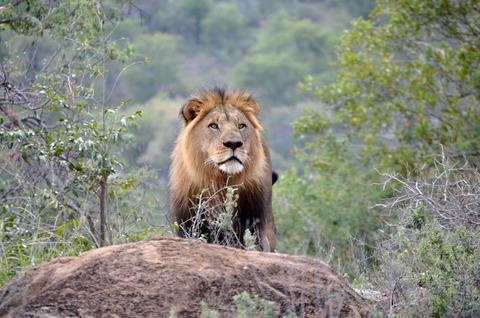Our official English website, www.x-mol.net, welcomes your feedback! (Note: you will need to create a separate account there.)
Do spotted hyaenas outcompete the big cats in a small, enclosed system in South Africa?
Journal of Zoology ( IF 2 ) Pub Date : 2020-02-24 , DOI: 10.1111/jzo.12772 J. Comley 1 , C. J. Joubert 2 , N. Mgqatsa 1 , D. M. Parker 1, 3
Journal of Zoology ( IF 2 ) Pub Date : 2020-02-24 , DOI: 10.1111/jzo.12772 J. Comley 1 , C. J. Joubert 2 , N. Mgqatsa 1 , D. M. Parker 1, 3
Affiliation

|
Carnivores are adapted to kill, meaning sympatric carnivores can have particularly aggressive and harmful competitive interactions. The co‐existence of multiple carnivores in an ecosystem could be restricted by their similarity in ecological niches (e.g. dietary overlap); however, high prey abundances could facilitate their co‐existence. Although the development of small, enclosed reserves (<400 km2) in South Africa has reduced human–carnivore conflict, these systems may increase the likelihood of carnivore intra‐guild competition due to the clumping of competing carnivores into these restricted spaces. Using carnivore scat and kill site analyses, we determined the dietary preferences and overlap of sympatric large carnivores in a small, enclosed reserve, Selati Game Reserve (Selati). Large carnivores in Selati (lions (Panthera leo), spotted hyaenas (Crocuta crocuta) and leopards (Panthera pardus)) preferentially selected for varying combinations of prey size classes. Lions selected for large prey, leopards selected for small prey and spotted hyaenas did not prefer any particular prey size. Additionally, lions had the largest dietary breadth and the diet of leopards and spotted hyaenas overlapped considerably. Coupled with high prey densities in Selati, the predation strategies of the large carnivores could be facilitating their co‐existence. On the other hand, the high degree of dietary overlap among large carnivores suggests that there is strong potential for exploitation competition, particularly between spotted hyaenas and leopards as their diet overlapped extensively (91% and 93% for prey species and size class, respectively). Although spotted hyaenas are potentially outcompeting leopards in Selati, lions were the most dominant large carnivore. Our study reiterates the complexity of carnivore guild interactions and emphasizes how these interactions are subject to variation due to site‐specific circumstances (e.g. composition of prey and carnivore populations). We therefore encourage site‐specific, multi‐carnivore research throughout protected areas in southern Africa.
中文翻译:

在南非的小型封闭系统中,斑点鬣狗是否能比大型猫竞争?
食肉动物适于杀死,这意味着同胞食肉动物可能具有特别具有侵略性和有害竞争性的相互作用。多个食肉动物在生态系统中的共存可能受到它们在生态位中相似性的限制(例如,饮食重叠);但是,高的猎物数量可以促进它们的共存。尽管开发了小型封闭式保护区(<400 km 2)在南非,人类食肉动物之间的冲突有所减少,由于竞争的食肉动物聚集在这些受限的空间内,这些系统可能会增加食肉动物公会内部竞争的可能性。使用食肉动物的粪便和杀死部位的分析,我们确定了小型封闭式保护区Selati Game Reserve(Selati)中同伴大型食肉动物的饮食偏好和重叠情况。大型肉食动物在Selati(狮子(Panthera leo),斑点鬣狗(Crocuta crocuta)和豹子(Panthera pardus))优先选择,以适应不同大小的猎物组合。选择大型猎物的狮子,选择小型猎物的豹子和斑点鬣狗不喜欢任何特定大小的猎物。此外,狮子的饮食范围最大,豹子和斑鬣狗的饮食重叠很多。再加上塞拉提的高密度猎物,大型食肉动物的捕食策略可能会促进它们的共存。另一方面,大型食肉动物之间的饮食重叠程度很高,这表明剥削竞争具有很大的潜力,尤其是斑鬣狗和豹子之间的饮食重叠很大(猎物种类和大小等级分别为91%和93%) 。尽管斑鬣狗可能会在塞拉提战胜豹子,狮子是最主要的大型食肉动物。我们的研究重申了食肉动物行会互动的复杂性,并强调了这些互动如何因特定地点的环境(例如猎物和食肉动物的种群)而发生变化。因此,我们鼓励在整个南部非洲保护区进行针对特定地点的多食肉动物研究。
更新日期:2020-02-24
中文翻译:

在南非的小型封闭系统中,斑点鬣狗是否能比大型猫竞争?
食肉动物适于杀死,这意味着同胞食肉动物可能具有特别具有侵略性和有害竞争性的相互作用。多个食肉动物在生态系统中的共存可能受到它们在生态位中相似性的限制(例如,饮食重叠);但是,高的猎物数量可以促进它们的共存。尽管开发了小型封闭式保护区(<400 km 2)在南非,人类食肉动物之间的冲突有所减少,由于竞争的食肉动物聚集在这些受限的空间内,这些系统可能会增加食肉动物公会内部竞争的可能性。使用食肉动物的粪便和杀死部位的分析,我们确定了小型封闭式保护区Selati Game Reserve(Selati)中同伴大型食肉动物的饮食偏好和重叠情况。大型肉食动物在Selati(狮子(Panthera leo),斑点鬣狗(Crocuta crocuta)和豹子(Panthera pardus))优先选择,以适应不同大小的猎物组合。选择大型猎物的狮子,选择小型猎物的豹子和斑点鬣狗不喜欢任何特定大小的猎物。此外,狮子的饮食范围最大,豹子和斑鬣狗的饮食重叠很多。再加上塞拉提的高密度猎物,大型食肉动物的捕食策略可能会促进它们的共存。另一方面,大型食肉动物之间的饮食重叠程度很高,这表明剥削竞争具有很大的潜力,尤其是斑鬣狗和豹子之间的饮食重叠很大(猎物种类和大小等级分别为91%和93%) 。尽管斑鬣狗可能会在塞拉提战胜豹子,狮子是最主要的大型食肉动物。我们的研究重申了食肉动物行会互动的复杂性,并强调了这些互动如何因特定地点的环境(例如猎物和食肉动物的种群)而发生变化。因此,我们鼓励在整个南部非洲保护区进行针对特定地点的多食肉动物研究。



























 京公网安备 11010802027423号
京公网安备 11010802027423号